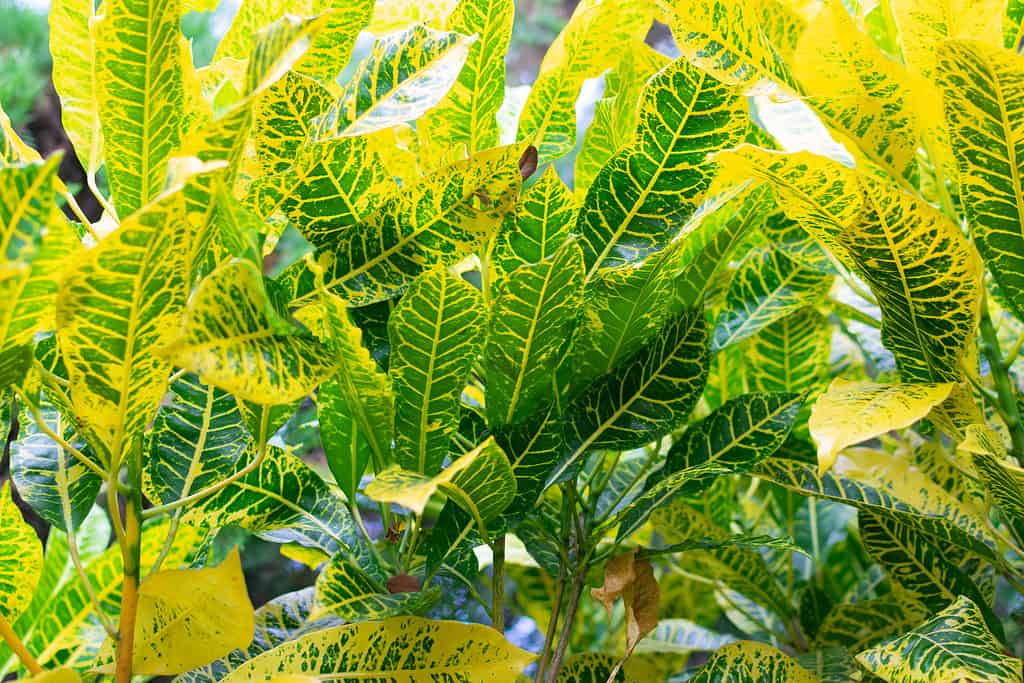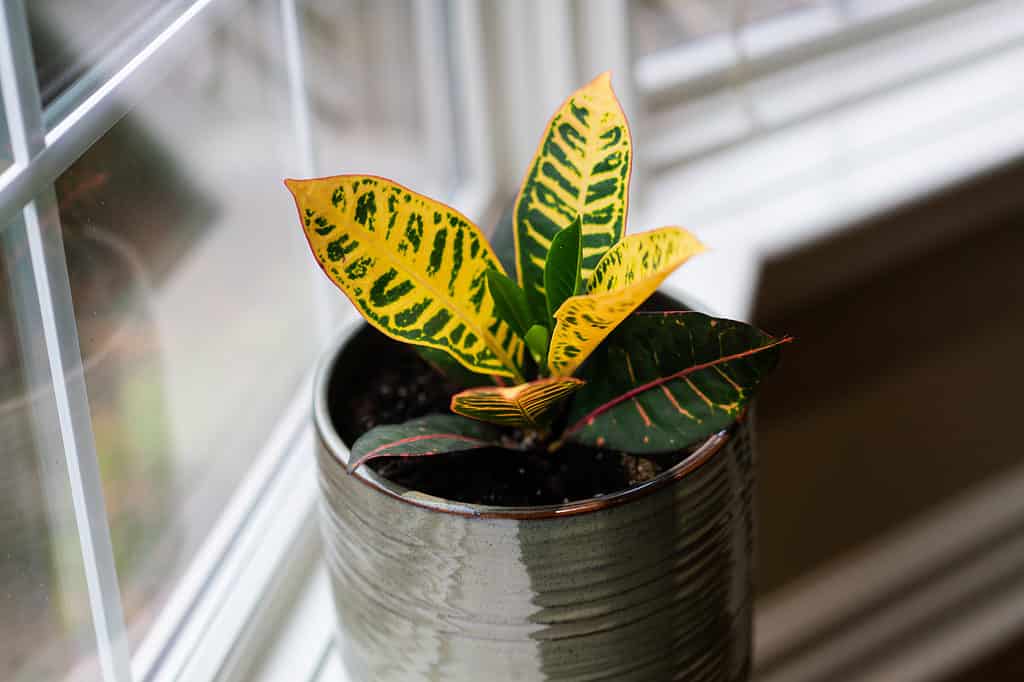Crotons, also known as Codiaeum variegatum, are stunning indoor plants cultivated for their vibrant and eye-catching leaves. Because of its thick, oval, pointed leaves that are covered in a rainbow of colors such as crimson, pink, burgundy, orange, yellow, and green, they are also known as the “Joseph’s coat” plant. Small, star-shaped blooms in white or yellow may also bloom throughout the summer on this plant. To put it simply, crotons can be real stunners!
Outdoor Codiaeum variegatum plants are most successful and hardy in warm, humid areas. They prefer lots of water and full or possibly dappled light. Unless you can reproduce their optimal environment from their native land, it might be difficult to grow croton plants inside. They tend to stay quite small when grown indoors, compared to the whopping eight feet that they can grow outside.
With all this in mind, you might still want to grow a beautiful Codiaeum variegatum plant. If you’ve got the time, it’s absolutely worth growing this stunning tropical eye-catcher! In this article, we’ll break down the basics to help you get started.
What is Codiaeum Variegatum?
The ubiquitous houseplant Codiaeum variegatum (commonly known as the croton plant) is often kept for its eye-catching foliage. The Codiaeum genus, which belongs to the Euphorbiaceae family, has six species of broadleaf evergreen perennials, shrubs, and small trees that are indigenous to countries across tropical and subtropical Asia and the Pacific Islands.
It’s worth noting that this species is often confused with the genus Croton, which is a completely different genus in the same family as Codiaeum, in which Codiaeum variegatum was formerly incorrectly classified as Croton variegatum. They can look quite similar, so try not to mix them up!
Numerous varieties of this evergreen shrub or small tree have been created, each with distinctive leaf color and pattern variations. It is a perennial that is only hardy in USDA hardiness zones 11 and 12, though many have had luck growing this species in zones nine and 10.
Codiaeum Variegatum Features
Croton is a branching, bushy shrub that may reach a height of 8 or even 10 feet in its natural habitat. The glossy, alternating leaves can range in shape from linear to oval, with a smooth or lobed margin that is occasionally severely cut to the midrib. Some of the leaves also have wavy or spiraling edges. The color of the leaf can vary from green to white, pink, red, or yellow in different combinations.
Codiaeum variegatum is similar to the majority of Euphorbiaceae plants in that it is technically poisonous to humans and animals. Those who handle it may get contact dermatitis from the milky sap that flows from damaged stems. As a result, it is often recommended to use gloves when pruning this type of plant.
When cultivated inside, Codiaeum variegatum seldom produces blooms. In April, while growing in the ground in regions without frost, it can eventually (though not always) produce small flowers. Female pollinated flowers are followed by fruits, which are tiny tripartite capsules with three tiny seeds, each measuring approximately a third of an inch in diameter.

The Petra croton (pictured) is a
Codiaeum variegatumvariety with vibrant yellow leaves.
©iStock.com/SOMNATH MAHATA
How to Grow a Codiaeum Variegatum
All Codiaeum species like sunny locations. They thrive with lots of indirect light and, preferably, some shadow protection from the intense midday heat. Despite this, they dislike being moved around often and will certainly let you know when they are unhappy. Codiaeum variegatum plants are notoriously mopey. This means they have a tendency to droop and drop their leaves when moved around. If given too much or too little water, or given too much or too little sun. Keep your croton in one spot once you’ve found a suitable location.
Sheltered locations that aren’t exposed to wind are ideal for this plant. Although there are dozens of varieties of Codiaeum variegatum, those with brighter and more variegated leaves need more light. This helps to maintain the vibrancy of their foliage colors.
As we mentioned earlier, this species will act dramatically if conditions are not ideal. When transported, some crotons experience stress and lose their leaves. It goes without saying that a new owner may be anxious during this period. This might be especially true if you’ve just moved your Codiaeum variegatum from a nursery to your home. As long as you give them the right conditions in their new home, they will eventually perk back up.
Light and Temperature Needs for Codiaeum Variegatum
Croton plants must be grown in intense light in order to develop their gorgeous colorful leaves. However, because they usually reside on the forest floors of tropical forests in Southeast Asia, they also dislike getting scorched by the hot sun during midday. Put some shade cloth around your plants if you are in an oppressively hot or dry location. This will help them absorb less of the sun’s UV radiation during the hottest part of the day. Or, better yet, replicate their natural environment and place them underneath a tree for all-natural shade.
Give croton plants ample light with brighter areas near windows or under grow lights if you’re growing them inside. They may be grown outside, but keep them inside when it becomes hotter than 80 degrees F or when it is colder than 55 degrees F.
Humidity and Water Needs for Codiaeum Variegatum
Codiaeum variegatum plants enjoy lots of humidity, as the majority of tropical plants. Set your croton plant on top of a rock tray with some water in it to assist in maintaining moisture surrounding the plant. The humidity in the air will rise if you’re growing yours as a hanging plant. This way, you can help boost the humidity around your plant without having to overwater it potentially.
Only water croton plants when the top half-inch to one-inch of soil feels dry to the touch since they prefer damp soil but dislike having too-wet roots. When you water them, do so until water begins to emerge from the container’s bottom. Then, let the soil dry up completely before watering it once more.
Overwatering can be harmful to croton plants. If you notice that the leaves on your croton are withering, there may be too much soil moisture or water in the environment. Your croton plant is thirsty if the lowest leaves are drying out or dropping off, which is an indication that you’ve been underwatering it. Keep the soil continually wet, and you should be a-ok!

It is crucial not to overwater or underwater potted Codiaeum variegatum plants (pictured), or they could start to decline.
©iStock.com/Regina Burganova
Soil and Fertilizer Needs for Codiaeum Variegatum
Croton plants favor organically rich, well-draining soil. The majority of acceptable potting soils are fine. Keep in mind that the recommended pH range for soil is between 4.5 and 6.5, though some will thrive in soil with a pH as high as 7.0. Both very calcium-rich soils and rocky soils with a high pH are not recommended for Codiaeum variegatum. Most likely, the potting soil you may buy at the big-box retailer nearby is adequate.
An 8-2-10 or 3-1-2 combination is a common fertilizer type for croton plant care since they want a lot of potassium. Most frequently, they are given a strong slow-release acidic fertilizer in the early spring and again in the late spring, which will nourish them throughout the early summer. Around mid-July, younger croton plants could need a third feeding. When it gets close to autumn, avoid fertilizing outside of the growing season since the leaves require time to develop and harden off before winter.
How to Repot a Codiaeum Variegatum
Your Codiaeum variegatum plant will ultimately reach the size where it requires a larger pot as it develops. Croton plant maintenance includes repotting. Choose a container that is only one to two inches wider in diameter than the one it is currently in, and fill the bottom of the new pot with part of your potting mix. Next, gently and cautiously remove your Codiaeum variegatum plant from its previous container.
If it seems to be a little root-bound, use your fingers to separate the roots gently. If the roots are overly intertwined, softly score them with a potting knife or a regular knife that has been sterilized. After that, insert the croton plant into the container, ensuring sure there is enough potting soil beneath to bring it to the top of the pot by about an inch.
If more dirt is required, carefully pour it around the edges of the plant. Then, water the plant thoroughly to saturate the soil and aid in its settling evenly. Stop watering when water begins to emerge from the pot’s bottom.
As we’ve mentioned before, this species is dramatic. Don’t be surprised if it droops for a bit after being repotted.

Crotons (pictured) make excellent potted plants and are quite easy to repot.
©iStock.com/Wirestock
Potential Difficulties Growing Codiaeum Variegatum
Croton plants staying green and not very colorful is perhaps the most typical growth issue that plant parents encounter. If your variety of Codiaeum variegatum is meant to have vibrantly colored leaves, but all of them are dark green instead, you could have a lighting issue.
While certain croton plant kinds really like partial shade. However, if they are dull in color when they are supposed to be red, orange, or yellow, that means it isn’t getting enough light to develop those vibrant tones. Bright light and a good temperature range between 60 and 80 degrees F are preferred by croton plants. Correct this issue, and your plant’s colors will start coming through.
Croton leaves may have areas of grayish color if the plant is directly exposed to harsh summer light. This often indicates that the leaves are dying as a result of excessive heat from too much direct sunlight. It will help to add a shade cloth or move your croton plants to an area with more natural shade during the warmest hours of the day.
Codiaeum variegatum is a very special species of plant that you won’t find very often due to its pickiness in humidity and temperature. However, if you’re willing to put in the work, you’ll end up with a very stunning and healthy croton plant that will last for quite a long time.
Want to learn more about the incredible croton plant? Take a look at our complete guide to everything croton-related!
The photo featured at the top of this post is © IrynaL/Shutterstock.com
FAQs (Frequently Asked Questions)
Is Codiaeum variegatum a good indoor plant?
Yes, Codiaeum variegatum is ideal for growing indoors.
Is Codiaeum variegatum toxic?
Codiaeum variegatum and similar species are toxic to cats, dogs, and even humans. While not necessarily deadly, this plant can cause stomach upset or contact dermatitis.
Do Codiaeum variegatum plants do better outside or inside?
Codiaeum variegatum can survive outside in USDA hardiness zones nine through 11.
Thank you for reading! Have some feedback for us? Contact the AZ Animals editorial team.






